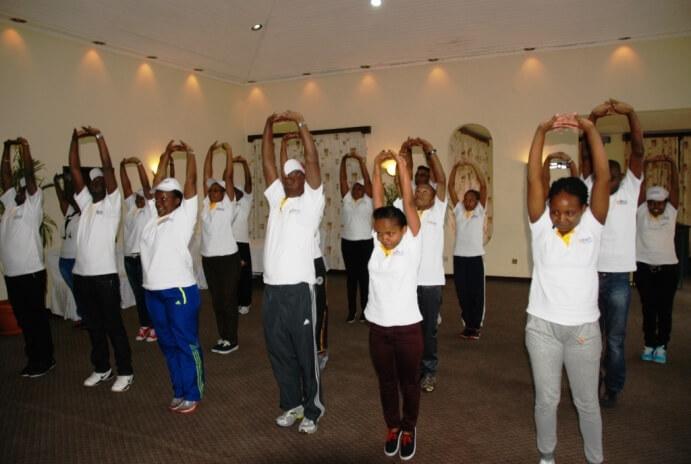Have you ever been in a team building session or in a meeting and the term icebreakers is mentioned? I bet the reactions expressed in the room were diverse. Some people probably smiled at the thought because they enjoy icebreakers. Others could have cringed because they have a fear of being embarrassed.
Many times, icebreakers have been associated with negative connotations. For instance, asking new employees very intimate questions or pushing them to perform in front of a group before they are comfortable with their new co-workers could be a tad embarrassing.
When careful thought is placed on team building ice breakers, the ice breakers encourage collaboration and communication skills, enhance employee engagement, generate energy, and most of all create a fun environment to work in. This is not always the case; some ice breakers tend to be forced, awkward, or inconsiderate of personality types, giving the ice-breaking sessions a deleterious effects.
Team Building Ice-Breakers
Team Building Ice breakers are good for breaking any awkward silence between people meeting for the first time, or maybe people in different managerial levels. They are also used to create rapport between the participants, making the conversation easy and pleasant. Here are some interesting scenarios and ice breakers that would be fun for employees:
Employee Training Programs
Any company’s human resource team knows how difficult it can be for both new and old employees to adapt and consistently adhere to the company's organizational culture. Employee training programs are usually organized to induct new employees and refresh or upgrade the old employees' knowledge and skills. Such training programs include: Customer Service Skills Training Programs and Sales Training Programs.
An ice breaker in a customer service training session, for example would get the employees to think on their feet when asked a ‘what if….’ question, where all participants get to voice their opinions and reasons for the path they choose. Here are some of the ice breakers that new employees can enjoy:
"What if" Scenarios:
The facilitator shares a scenario that leaves the participants with the question, ‘What if’ to answer. All participants get to respond to this scenario. This encourages creativity and it’s fun to hear all the different perspectives
Guess Whose Story This Is:
Participants get to write a true fun story, without indicating their names. The stories are placed in a jar. The facilitator picks one and reads it, and the others have to guess whose story that belongs to
Find The Silver Lining:
Participants share a previous workplace scenario and how it hurt them, the other participants have to find the positives in that story and point these out
I Agree to Disagree:
The facilitator writes down statements, assumptions or clichés related to the work place and participants share why they agree or disagree with the particular idea.
Relaxing: Indoor Team Building Ice Breakers
Indoor team building Ice breakers are good for in-house meetings or indoor team building sessions. They are also good for those employees that are natural introverts, who find going outdoors is too much to ask of them. Here are some fun ice breakers for indoor meetings and team building:
Guessing Game:
The facilitator imitates a few traits associated with an employee, a historical figure or a famous person, and the others have to guess who the person is
Office Quizzes:
The facilitator prepares a set of questions that challenge the people to think critically about the situation and find a solution
On the Hot Seat:
If all participants are comfortable with each other, they can get to learn their co-workers by asking personal non-offensive questions, with the respondent on a mock ‘Hot Seat’
Videos:
Share a video with participants, then ask them to seat in teams and come up with feedback, lessons learned and things to avoid from the video
On-toes: Outdoor Team Building Ice Breakers
Many times, companies organize corporate team building sessions. In such team building sessions, some of the fun activities to engage the employees could need an open outdoor space. Some of the intriguing outdoor team building ice breakers the team building facilitator could engage are:
Line Up:
The facilitator gives instructions that the group have to arrange themselves in a certain order without verbal communication. For example in order of their birth dates
Tag of War:
In color coded teams, the team give their best (champion) who has to compete with another one from a different team. The one who is pulled over joins the new team. The team that pulls most people over get to win a secret award
Treasure Hunt:
Prior to the activity, the facilitator hides clues that help the team to work together to find the treasure
Singing Competition:
While not everyone is a talented singer, this game should allow creativity and fun, so that all people participate without feeling awkward.
Egg On a Spoon:
The facilitator gets raw eggs and, in each group, a volunteer carries the egg on a spoon in the mouth. The participant who carries the egg furthest wins their team a prize; but the catch is that the team gets to share a work-related secret that they could use to improve performance, communication, etc.
Effective and Ineffective Icebreakers
Effective Ice Breakers
Effective icebreakers are fun, interactive and memorable. But how does one ensure effectiveness when presented with different personalities?
- Give it a different title: Remember the different reactions to the term ‘icebreakers’? Coin a creative name for the session, which ensures everyone feels comfortable
- Salutation: Have an ‘usher’ that greets and smiles to all participants as they get into the room for the meeting. It makes people feel included
- Make new teams with every meeting: This will minimize the chances of team division not only in icebreaking sessions, but also in the office
Ineffective Ice Breakers
Based on factors such as personality types, age sets, and management levels, icebreakers can be ineffective. In team building meetings, the team building facilitator has to avoid boring, repetitive, and uninspired ice breakers. Some factors to check in ineffective ice breakers are:
- They are difficult: Icebreakers are meant for fun, not to expose knowledge levels of participants. When a participant feels intellectually challenged, they tend to be quiet
- They are frustrating: Icebreakers that bring about feelings of anger, unworthiness, excessive self-judgment, and self-loathe to the surface should not be entertained
- They are humiliating: People never ever want to feel humiliated in the presence of other people. Consider icebreakers that encourage interactions, rather than embarrassment.
Team building activities can become fun when the right icebreaker is used. Icebreakers encourage cooperation and collaboration, which translates to improved communication skills at the workplace.





